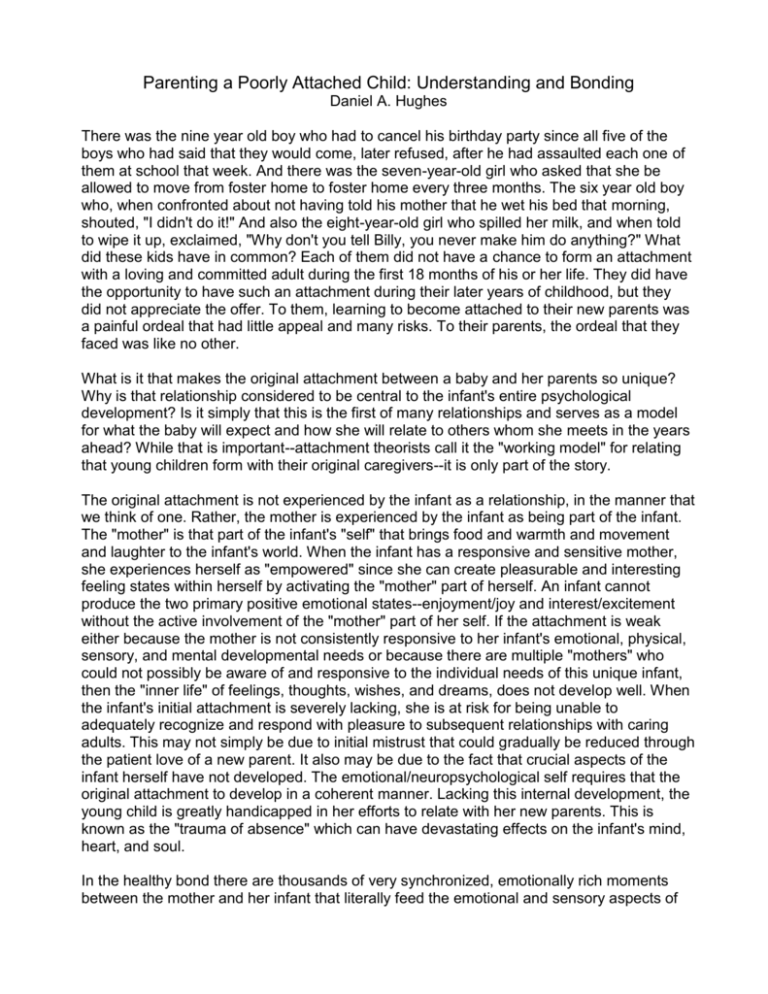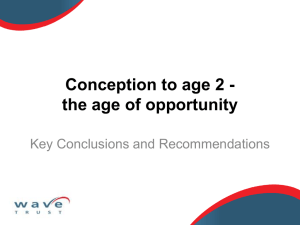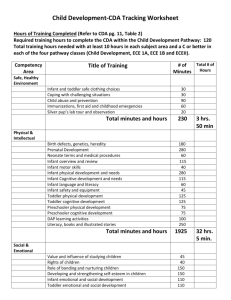Parenting a Poorly Attached Child: Understanding and Bonding
advertisement

Parenting a Poorly Attached Child: Understanding and Bonding Daniel A. Hughes There was the nine year old boy who had to cancel his birthday party since all five of the boys who had said that they would come, later refused, after he had assaulted each one of them at school that week. And there was the seven-year-old girl who asked that she be allowed to move from foster home to foster home every three months. The six year old boy who, when confronted about not having told his mother that he wet his bed that morning, shouted, "I didn't do it!" And also the eight-year-old girl who spilled her milk, and when told to wipe it up, exclaimed, "Why don't you tell Billy, you never make him do anything?" What did these kids have in common? Each of them did not have a chance to form an attachment with a loving and committed adult during the first 18 months of his or her life. They did have the opportunity to have such an attachment during their later years of childhood, but they did not appreciate the offer. To them, learning to become attached to their new parents was a painful ordeal that had little appeal and many risks. To their parents, the ordeal that they faced was like no other. What is it that makes the original attachment between a baby and her parents so unique? Why is that relationship considered to be central to the infant's entire psychological development? Is it simply that this is the first of many relationships and serves as a model for what the baby will expect and how she will relate to others whom she meets in the years ahead? While that is important--attachment theorists call it the "working model" for relating that young children form with their original caregivers--it is only part of the story. The original attachment is not experienced by the infant as a relationship, in the manner that we think of one. Rather, the mother is experienced by the infant as being part of the infant. The "mother" is that part of the infant's "self" that brings food and warmth and movement and laughter to the infant's world. When the infant has a responsive and sensitive mother, she experiences herself as "empowered" since she can create pleasurable and interesting feeling states within herself by activating the "mother" part of herself. An infant cannot produce the two primary positive emotional states--enjoyment/joy and interest/excitement without the active involvement of the "mother" part of her self. If the attachment is weak either because the mother is not consistently responsive to her infant's emotional, physical, sensory, and mental developmental needs or because there are multiple "mothers" who could not possibly be aware of and responsive to the individual needs of this unique infant, then the "inner life" of feelings, thoughts, wishes, and dreams, does not develop well. When the infant's initial attachment is severely lacking, she is at risk for being unable to adequately recognize and respond with pleasure to subsequent relationships with caring adults. This may not simply be due to initial mistrust that could gradually be reduced through the patient love of a new parent. It also may be due to the fact that crucial aspects of the infant herself have not developed. The emotional/neuropsychological self requires that the original attachment to develop in a coherent manner. Lacking this internal development, the young child is greatly handicapped in her efforts to relate with her new parents. This is known as the "trauma of absence" which can have devastating effects on the infant's mind, heart, and soul. In the healthy bond there are thousands of very synchronized, emotionally rich moments between the mother and her infant that literally feed the emotional and sensory aspects of the infant's young brain. Central to these reciprocal experiences are touch, smiles, eye contact, facial expressions and movement. Early childhood researchers call these moments "affective attunement" in which the mother's emotional state recognizes and instantly responds to the emerging emotional state of her baby. This experience of shared emotion nourishes the infant's ability to feel enjoyment/joy and interest/excitement. Without these countless attunement experiences with her mother, the infant will not be able to experience these emotions well, nor know that another person can be the source of such pleasure. She will then try to find her pleasure, small though it is, in ways that she can control. She will turn to repetitive movements, self-stimulation, or objects, since the emotionally rich world of relationships is not available. When an infant's world is consistently lacking in attunement experiences, her emerging self is diminished and she experiences pervasive shame. This type of shame is the feeling state that reflects a sense of being worthless due to being undeserving of shared affect with the mother. Rather than joy and excitement, the shame-ridden infant feels despair and terror in response to a cold and unpredictable world. She tries to force a response by screaming in rage. Eventually her screams become the tears of her inner pain. Finally, her tears also become quiet. When an infant has experienced a consistently attuned mother and has established a stable early attachment, she is able to accept and integrate the socialization demands that come with being a toddler. When her mother says "no", and thereby is misattuned with her emotional state, she feels shame, and she looks down and away. She is initially confused and troubled by her mother's failure to be attuned with her emotional and behavioral state. However, within a secure attachment, her mother quickly comforts and reassures her toddler that she remains special, that she simply is being taught that certain behaviors need to be limited, controlled or redirected. These experiences of healthy shame must occur for optimal development and a more fully developed attachment. Sequences of attunement, socialization with shame, and reassurance and reattunement lead to an integration of the young child's needs for a secure attachment with her needs for socialization and autonomy. She can become a special, unique individual, within a social world, while experiencing magical relationships with members of her family. When infants have experienced a lack of attunement and pervasive shame through neglect, they are not able to accept and integrate the much more circumscribed experience of socialization-shame and they can not be reassured that they have worth. For these poorly attached children, discipline is experienced as rejection and contempt. They do not respond to routine discipline, so necessary for socialization, without rage or despair. For these children, discipline does not serve to teach. Discipline is felt to be another statement that they are worthless and that they are not special to their parents. They then habitually overreact to the distress caused by routine discipline. Parental teaching is experienced as traumatic since it recreates the original pervasive shame experience that confirms that they are worthless and that their parents are cruel or indifferent to them. Their emotional lives consist primarily in experiences of terror, rage, and despair, rather than joy and excitement that is felt by the securely attached. Given an initial 18 months of too little attunement and too much shame, how will the poorly attached child live in her world? First, she will not seek out a special adult for comforting, safety, and reciprocal enjoyment. She will go to the adults who are "nice" at this moment in time, and discard them when they become "mean". She will develop her ability to manipulate adults into meeting her needs, since she cannot anticipate that they will naturally want to meet them. She will be either charming or aggressive to get what she wants, whichever is the most effective with a given adult or situation. Secondly, she will always seek to be in control of whatever situation that she is in, since she cannot relax and assume that the adult will naturally keep her safe and meet her needs. She will fight to maintain such control and she will seek revenge, either directly through aggression or destructiveness, or indirectly through lying, stealing, or breaking the rules when out of sight, whenever the adult frustrates her compulsion to be in charge. Third, she will not be able to tolerate reciprocal fun and love, since these qualities of her emotional development are deficient and also since she would have to reduce her control needs to be able to enjoy herself. She will both avoid fun and love and also sabotage others so engaged since those experiences elicit distant memories of her own rejection and sense of being worthless. Such memories are too painful to be acknowledged. Finally, the poorly attached child will not communicate well, either verbally or nonverbally, since it has been such a small part of her early development. Smiles, touch, eye contact, and verbal expression of her thoughts and feelings will be very difficult for her. Such communication also reminds her of her being worthless and undeserving of such magical moments of shared joy and interest with those one loves. How do we approach the young child who does not know how to dance, due to a lack of attunement experiences, and who cannot not tolerate routine discipline, due to the presence of pervasive shame? Children, who have experienced chronic abuse and neglect, multiple caregivers, either in a series of homes or in an orphanage, do not respond with excitement and joy when they finally encounter loving and committed parents. With these children, concrete behavioral reinforcers such as stickers, privileges, and trips to McDonalds, have no lasting value or influence over their angry and solitary existence. Giving them time-outs is experienced either as a rejection or as a chance to get away from annoying adults. Neither experience builds an attachment. Giving these children repeated "fresh starts" is the same as providing them with repeated failures and giving their parents an opportunity to feel used and manipulated. Soon, their parents forget how to dance with them and join them in the experience of shame. In this case, it is the shame of feeling like an inadequate parent. If parents are to have a meaningful chance to form an attachment with their children who can neither comprehend nor accept such a relationship, they must use the early motherinfant bond and the young child's first developmental stages as a guide. What attitude and behavior does the new mother manifest when she is attuned with her infant as well as when she is socializing him? What experiences does the young child have that maximizes his overall development? When a parent is attuned with her infant, she manifests an attitude that has five central characteristics. In general, she is able to maintain an attitude that is accepting, empathic, and loving, as well as curious and playful. She takes delight in and affirms whatever sounds, emotions and movements her infant manifests. She comforts and soothes, she reacts with surprise and exuberance, she hums and she hugs. She notices without judgement, whatever new actions her young child is demonstrating. She talks "baby talk" and giggles, makes funny faces and sings. The underlying attitude that these behaviors convey is ideally suited for facilitating an attachment with her infant. The same attitude is crucial in convincing a poorly attached 5, 8, or 10-year-old child that forming a reciprocal relationship with her parent does elicit varied and rich pleasurable feelings. The mother of a poorly attached child needs to touch her child, mess up his hair, play in the snow with him and read him stories. She needs to find ways to enjoy her child rather than constantly evaluate and criticize him. She needs to be deeply engaged in understanding her child, providing empathy for his distress, and showing him the joy and safety that lies within a good family. As every mother of a poorly attached child knows, this advice is much easier to say than to implement. How can she engage her child in reciprocal enjoyment when she is met either with sullen, angry, withdrawal or frantic, "can't get enough" impulsivity? How can she even try to engage her child playfully when she is responding to one act of defiance after the other, and then dealing with his rage over her efforts to provide him with discipline? Discipline cannot be avoided. Parents need to find a way to provide their child with discipline in a way that builds the attachment and does not weaken it. Without effective discipline, no effort to be playfully and lovingly attuned with her child will be successful. Poorly attached children respond best to discipline that involves choices and consequences. These children are very poor at comprehending the connection between their behavior and the consequences of their behaviors. Over and over again this connection needs to be made clear and concrete for them. However, to have any chance of success, this form of discipline needs to be presented with the same attitude that was discussed above. The qualities of acceptance, empathy, love, curiosity, and playfulness are at least as important in providing discipline as they are in communicating attunement. Habitual annoyance while providing discipline, which too often becomes a "side effect" of raising these children, will invariably undermine any chance for a developing attachment. During discipline, parents need to be able to make comments such as: “You chose not to pick up your toys and now you can't go out and play! I'm sad for you. Oh, well, you'll have another chance this afternoon. After you've talked with me without yelling about what you did, then we can get ready to go to your game. I know it's hard for you to do, and I'll be sad if you miss your game. I hope you can figure out a way. You'll have to leave the table tonight so the rest of us can enjoy our meal. I'll save yours for you. We'll miss you and we hope you choose to eat with us tomorrow.” This is just an excerpt from Dan Hughes chapter.





